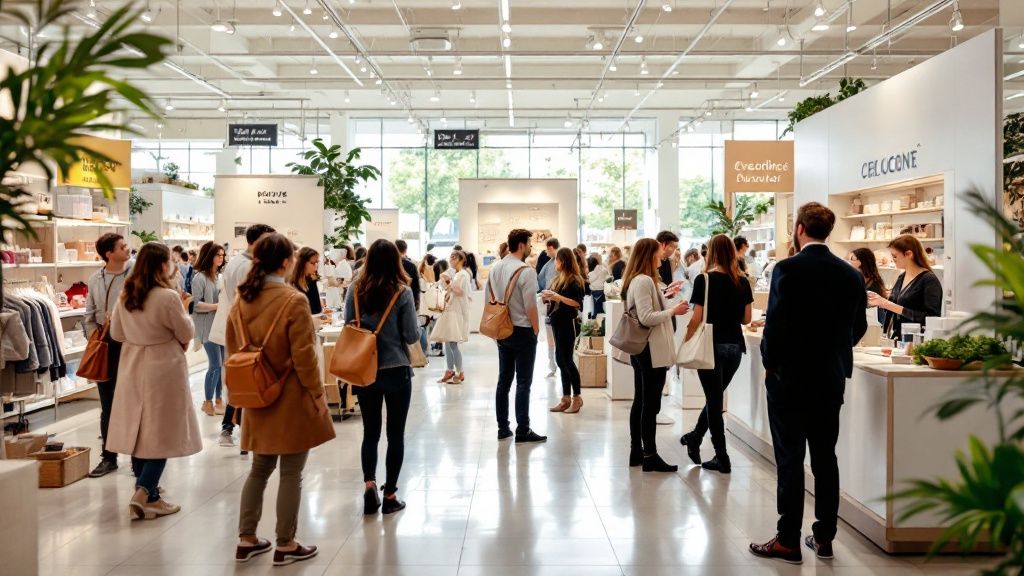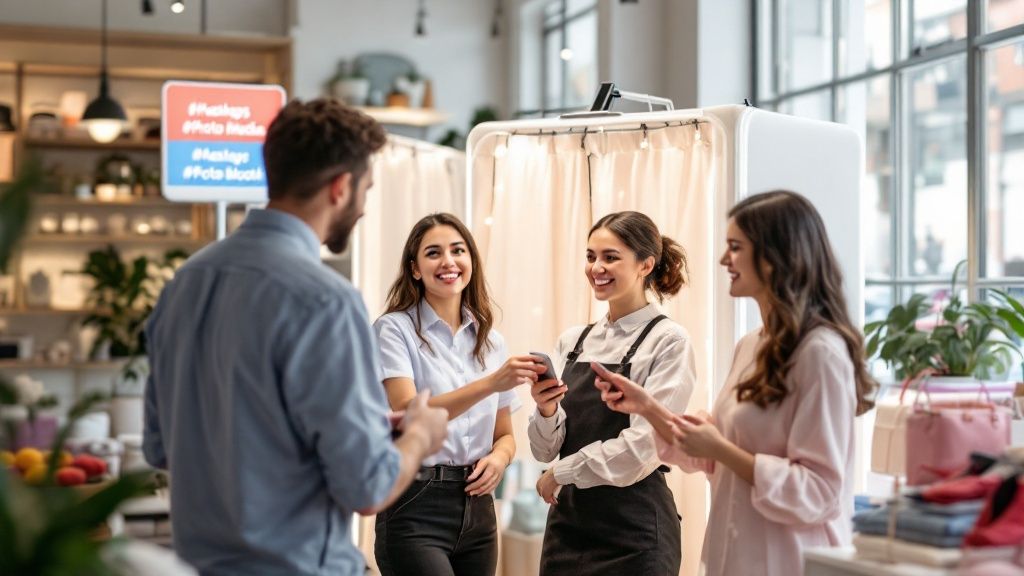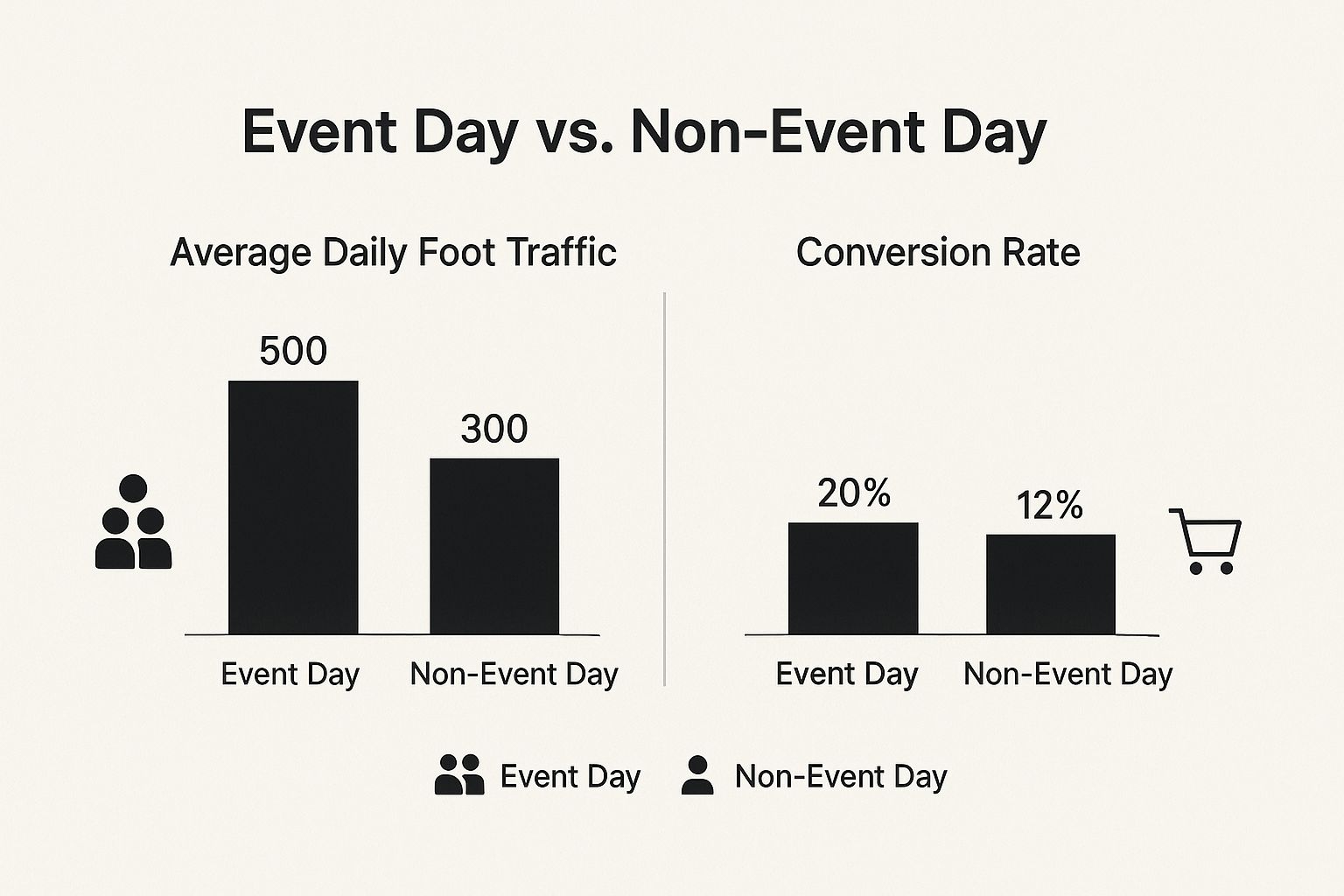

If you think you can win back customers with a simple sale, you're already behind. In a post-cookie world where digital advertising is in flux, the physical store isn't just a sales channel—it's your most powerful data hub and media platform. The retailers who understand this shift from transaction to experience will thrive. Those who don't will become obsolete.
Let's be honest: in a world of one-click buys and same-day delivery from giants like Amazon, getting customers through your physical doors is a bigger challenge than ever. The old playbook of "stock it, and they will come" is gathering dust on the shelf.
Why should a customer get in their car when they can have almost anything delivered to their doorstep?
The answer is an experience that goes beyond the transaction. Success today means transforming your store from a place where people buy things into a destination where they want to be. We’re focused on the evolution of physical stores into true destinations.
To really get this right, you’ll need to delve into experiential marketing strategies that give people a reason to choose your store over online shopping, here's a quick look at the core strategies we'll be covering to help you boost your in-store visits.
These strategies are connected—a well-promoted event online can bring new visitors into your well-designed store, and the data you collect can help improve future events.

Your physical space is a vital marketing tool that influences customers. The goal is to create an inviting atmosphere that fosters brand connection. It starts with your window display, which should captivate and draw in pedestrians, turning them into customers. Use dramatic lighting, unique props, and vivid colors to attract attention and encourage impulse buys.
Once customers enter, their journey is just beginning. Your store's layout should guide them naturally and interestingly, encouraging exploration. Avoid cluttered aisles, as they cause frustration.
Many retailers overlook that an effective layout goes beyond shelving; it’s about managing flow and creating comfort, impacting how long customers stay and how much they spend.
A well-designed layout can make a small shop feel open or a large one intimate. Depending on your brand, consider these layouts:
The layout of your store guides the customer's journey, with Smart AI screens enhancing product discovery and boosting sales through dynamic inventory displays. Placing AI screens along a circular path ensures customers explore all areas and don't miss important sections. Highlight exciting products and new arrivals on these screens to grab attention. Creating "zones" with AI screens, such as a "cozy living" area in a home goods store, helps customers visualize items in their homes, facilitating natural purchasing decisions. Your layout acts as a silent salesperson, with AI screens directing attention and telling product stories to make navigation intuitive and discovery effortless.
Sensory marketing involves engaging multiple senses to strengthen emotional connections with customers. Creating a well-crafted atmosphere encourages comfort, leading to longer visits and increased spending.

For brick-and-mortar retailers, attracting customers often starts online. Consider your digital presence as your shop's new front door. Mastering local search is crucial for increasing foot traffic, making you the go-to answer for searches like "coffee shop near me" or "boutique open now."
Your key tool in this is your Google Business Profile (GBP). More than just an online listing, it's your digital storefront. An incomplete profile is like an unappealing window display, suggesting you may not be the best option.
Optimizing your GBP significantly benefits your business, going beyond just listing your address and hours. A well-managed profile acts as a dynamic billboard, encouraging customers to visit.
Focus on these areas:
Let this sink in: 87% of shoppers start looking for products online. If your GBP isn't popping with current products and fresh updates, you're basically invisible to the huge majority of your potential local customers.
Geo-targeted social media ads are effective for reaching local audiences. Platforms like Facebook and Instagram allow you to display ads to users near your store, maximizing your ad spend. To enhance local appeal, avoid generic messaging and instead offer in-store promotions or highlight local events. Understanding local behavior, such as seasonal trends, is essential. For example, Walmart's store visits increased by 2.01% due to summer demand for BBQ supplies. Aligning products with local trends can boost store traffic. For more insights, explore specialized local SEO services and summer retail trends on Passby.com.
In a digital age, physical stores offer the unique advantage of creating shared experiences. Experiential retail encourages visits by offering something screens cannot. The goal is to transition from merely selling products to becoming a community hub centered on shared interests. By fostering memorable connections and excitement, your store becomes a destination, building a loyal customer base.
Authentic in-store events should align with your brand and offer real value to your audience. Move beyond simple sales and focus on experiences that foster learning and connection.
Consider these ideas:
The data below really drives home the impact events can have. It compares average foot traffic and conversion rates on days we held an event versus regular days.

As you can see, events don't just bring more bodies through the door—they bring in engaged people who are significantly more likely to become paying customers.
Promotions can increase foot traffic, but should be used cautiously. While deep discounts may temporarily boost visitors, they can lead customers to expect sales, diminishing brand value. For instance, a 15.9% increase in U.S. fashion store visits one March due to spring collections and flash sales wasn't sustained, as traffic fell 7.84% the following month, indicating promotions aren't a lasting solution, You can see more details in the data on seasonal retail foot traffic.
The trick is to create urgency through exclusivity and excitement, not just by slashing prices. Limited-edition product drops or loyalty-member-only shopping nights build genuine anticipation and make customers feel special, driving visits without devaluing your products.
At the end of the day, turning your store into a community hub is about building relationships that stick. Memorable experiences and smart promotions work hand-in-hand to build a loyal customer base—the true key to long-term success. For more ideas on this, check out our guide on how to increase shopper retention.
Guesswork can be costly in retail. Successful brands rely on customer insights rather than intuition. So it is important to Level Up Your Retail Store's Customer Service. Using in-store analytics effectively is key to growth. Start by tracking basics like busy hours, customer dwell time, and popular areas. This valuable data aids in optimizing staff schedules and product placement.
Once you establish a baseline, delve deeper. Are Saturday shoppers purchasing differently than weekday visitors? Do those who linger by the window display end up buying more? Answering such questions refines your strategy.
Recent data indicates a trend toward value shopping. While U.S. retail foot traffic increased by 0.4% year-over-year, discount stores saw a 2.8% growth, and grocery stores a 2.27% increase, showing that in-person shoppers are mindful of their spending. More insights are available at GrowthFactor.ai.
Let’s break down what this really means for brands. The goal isn’t just to collect data; it's to ask the right questions. Your analytics should tell you a story about your customers' behavior, revealing opportunities you would have otherwise missed.
Numbers show what is happening, but direct feedback explains why. Both are essential for a complete understanding. Fortunately, gathering insights can be simple and affordable.
Consider these methods:
By merging data with personal feedback, you can stop guessing and start strategizing effectively.
Rolling out new strategies often raises questions. This guide addresses common inquiries from retailers aiming to increase foot traffic, providing insights on measuring success, optimizing efforts, and avoiding pitfalls.
Understanding your store's visitor numbers is crucial. Tools like Wi-Fi analytics, beacons, and door counters help track this data. Compare traffic from events, like weekend workshops, to typical weekends for insights. Additionally, analyze digital clues like "directions requests" in your Google Business Profile to align traffic data with sales for a true conversion rate.
With a limited budget, prioritize high-impact, low-cost tactics. A complete Google Business Profile is essential for local searches. Building an email list for in-store exclusives offers direct communication with loyal customers. Excellent customer service generates positive word-of-mouth marketing. Collaborate with nearby businesses for cross-promotions to share audiences and costs.
Maintain a balance to avoid "promo fatigue" and protect your brand's value. Create a strategic promotional calendar:
This approach keeps your store relevant while maintaining brand integrity through value-based experiences.
Ready to transform your in-store experience and unlock new revenue streams? Intouch.com provides an AI-driven media network that helps you deliver personalized promotions, gather powerful customer insights, and monetize your physical space. See how Intouch.com can drive measurable results for your business.